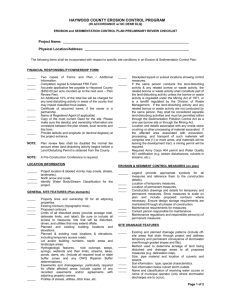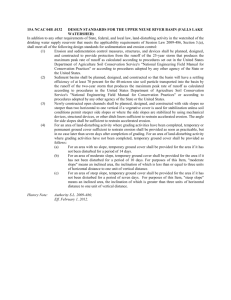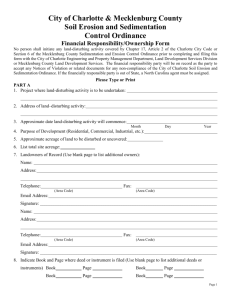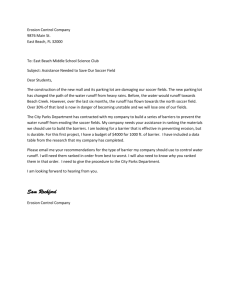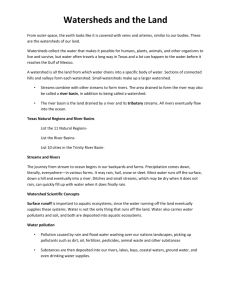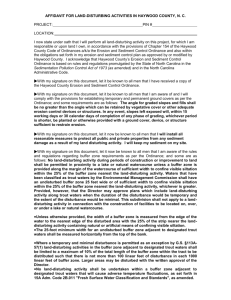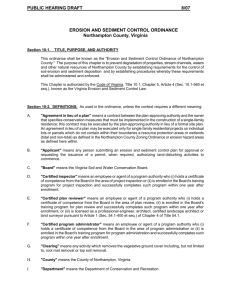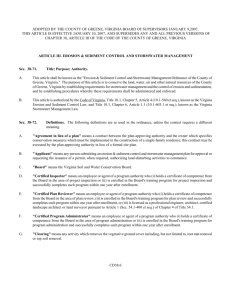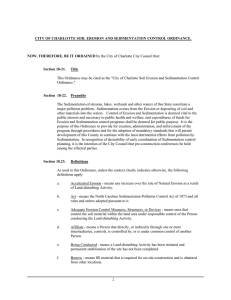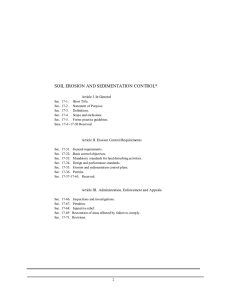DOC - ncrules.state.nc.us
advertisement
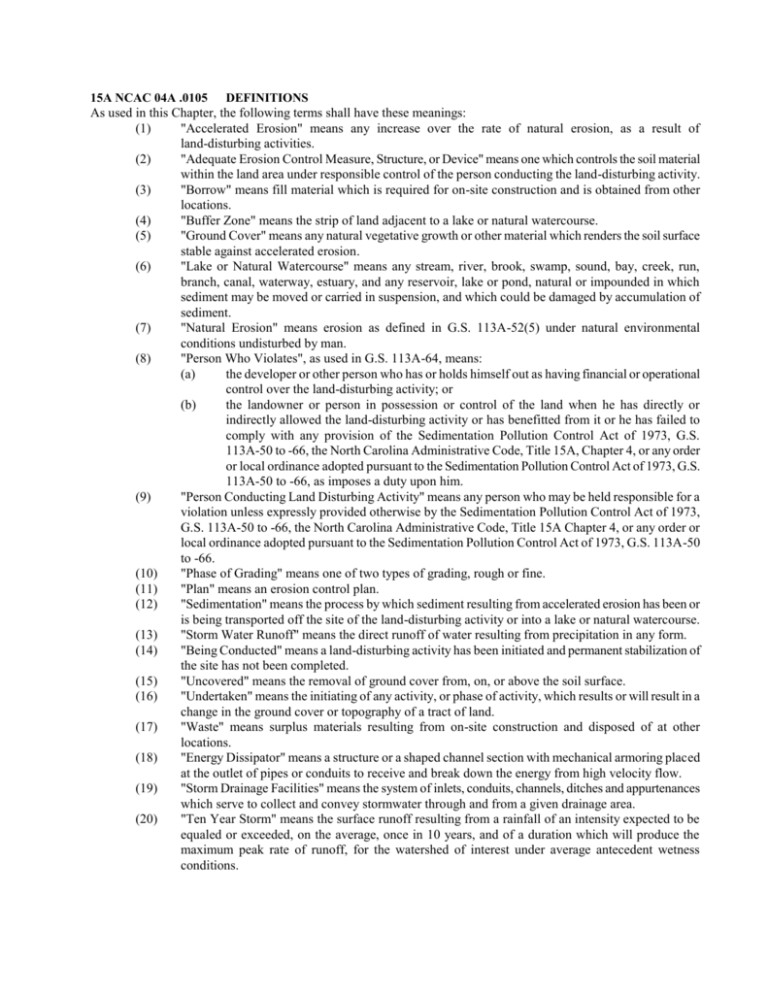
15A NCAC 04A .0105 DEFINITIONS As used in this Chapter, the following terms shall have these meanings: (1) "Accelerated Erosion" means any increase over the rate of natural erosion, as a result of land-disturbing activities. (2) "Adequate Erosion Control Measure, Structure, or Device" means one which controls the soil material within the land area under responsible control of the person conducting the land-disturbing activity. (3) "Borrow" means fill material which is required for on-site construction and is obtained from other locations. (4) "Buffer Zone" means the strip of land adjacent to a lake or natural watercourse. (5) "Ground Cover" means any natural vegetative growth or other material which renders the soil surface stable against accelerated erosion. (6) "Lake or Natural Watercourse" means any stream, river, brook, swamp, sound, bay, creek, run, branch, canal, waterway, estuary, and any reservoir, lake or pond, natural or impounded in which sediment may be moved or carried in suspension, and which could be damaged by accumulation of sediment. (7) "Natural Erosion" means erosion as defined in G.S. 113A-52(5) under natural environmental conditions undisturbed by man. (8) "Person Who Violates", as used in G.S. 113A-64, means: (a) the developer or other person who has or holds himself out as having financial or operational control over the land-disturbing activity; or (b) the landowner or person in possession or control of the land when he has directly or indirectly allowed the land-disturbing activity or has benefitted from it or he has failed to comply with any provision of the Sedimentation Pollution Control Act of 1973, G.S. 113A-50 to -66, the North Carolina Administrative Code, Title 15A, Chapter 4, or any order or local ordinance adopted pursuant to the Sedimentation Pollution Control Act of 1973, G.S. 113A-50 to -66, as imposes a duty upon him. (9) "Person Conducting Land Disturbing Activity" means any person who may be held responsible for a violation unless expressly provided otherwise by the Sedimentation Pollution Control Act of 1973, G.S. 113A-50 to -66, the North Carolina Administrative Code, Title 15A Chapter 4, or any order or local ordinance adopted pursuant to the Sedimentation Pollution Control Act of 1973, G.S. 113A-50 to -66. (10) "Phase of Grading" means one of two types of grading, rough or fine. (11) "Plan" means an erosion control plan. (12) "Sedimentation" means the process by which sediment resulting from accelerated erosion has been or is being transported off the site of the land-disturbing activity or into a lake or natural watercourse. (13) "Storm Water Runoff" means the direct runoff of water resulting from precipitation in any form. (14) "Being Conducted" means a land-disturbing activity has been initiated and permanent stabilization of the site has not been completed. (15) "Uncovered" means the removal of ground cover from, on, or above the soil surface. (16) "Undertaken" means the initiating of any activity, or phase of activity, which results or will result in a change in the ground cover or topography of a tract of land. (17) "Waste" means surplus materials resulting from on-site construction and disposed of at other locations. (18) "Energy Dissipator" means a structure or a shaped channel section with mechanical armoring placed at the outlet of pipes or conduits to receive and break down the energy from high velocity flow. (19) "Storm Drainage Facilities" means the system of inlets, conduits, channels, ditches and appurtenances which serve to collect and convey stormwater through and from a given drainage area. (20) "Ten Year Storm" means the surface runoff resulting from a rainfall of an intensity expected to be equaled or exceeded, on the average, once in 10 years, and of a duration which will produce the maximum peak rate of runoff, for the watershed of interest under average antecedent wetness conditions. (21) (22) (23) (24) (25) (26) (27) (28) History Note: "Velocity" means the average velocity of flow through the cross section of the main channel at the peak flow of the storm of interest. The cross section of the main channel shall be that area defined by the geometry of the channel plus the area of flow below the flood height defined by vertical lines at the main channel banks. Overload flows are not to be included for the purpose of computing velocity of flow. "Discharge Point" means that point at which runoff leaves a tract of land. "Completion of Construction or Development" means that no further land-disturbing activity is required on a phase of a project except that which is necessary for establishing a permanent ground cover. "High Quality Waters" means those classified as such in 15A NCAC 2B .0101(e)(5) - General Procedures, which is incorporated herein by reference to include further amendments. "High Quality Water (HQW) Zones" means areas in the Coastal Counties that are within 575 feet of High Quality Waters and for the remainder of the state areas that are within one mile of and drain to HQW's. "Director" means the Director of the Division of Energy, Mineral, and Land Resources of the Department of Environment, Health, and Natural Resources. "Coastal counties" means the following counties: Beaufort, Bertie, Brunswick, Camden, Carteret, Chowan, Craven, Currituck, Dare, Gates, Hertford, Hyde, New Hanover, Onslow, Pamlico, Pasquotank, Pender, Perquimans, Tyrrell and Washington. "Twenty-five Year Storm" means the surface runoff resulting from a rainfall of an intensity expected to be equaled or exceeded, on the average, once in 25 years, and of a duration which will produce the maximum peak rate of runoff, from the watershed of interest under average antecedent wetness conditions. Filed as a Temporary Amendment Eff. January 14, 1992 for a period of 180 days to expire on July 11, 1992; Filed as a Temporary Amendment Eff. November 1, 1990 for a period of 180 days to expire on April 29, 1991; Statutory Authority G.S. 113A-52; 113A-54; Eff. November 1, 1984; Amended Eff. May 1, 1990; ARRC Objection Lodged November 14, 1990; ARRC Objection Removed December 20, 1990; Amended Eff. August 1, 2012 (see S.L. 2012-143, s.1.(f)); October 1, 1995; April 1, 1992; January 1, 1991.
